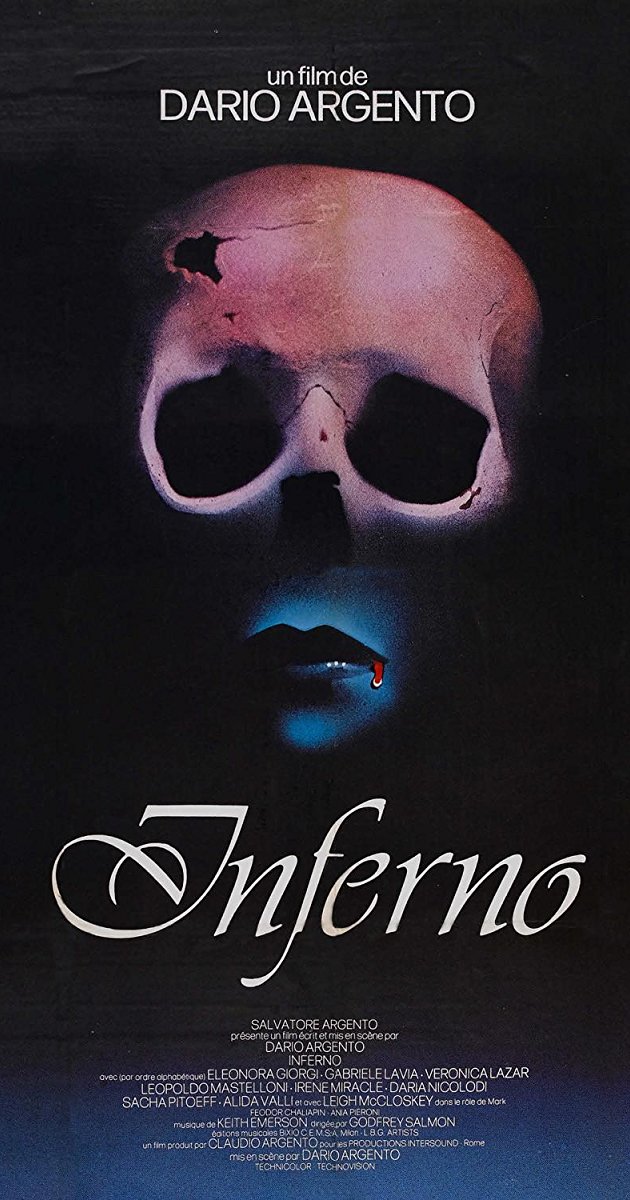Yes, these aren't full-blown gialli, blah blah blah, but they do both draw heavily on giallo iconography and they're made by Dario Argento and Mario Bava was involved with the production of Inferno and just shut up, alright?
I'm not going to write in-depth about these films-better writers than I, as well as Alan Jones, have already written reams on them-and it's boring to continue the jaded debate as to whether these films are gialli, but I'll briefly address that hoary old topic. Sure, they're predominantly supernatural horror films, BUT...
-their plots are constructed around baroque murder set pieces
-the murders are committed by disembodied gloved hands/arms (not literally you fool, but the killers are faceless)
-there is a mystery element, with Inferno in particular incorporating a whodunnit aspect
-they follow amateur investigations
-they have pounding music scores (of varying quality)
So, even if they don't tick every giallo box, they're far from divorced from the filone. (I've ignored the trilogy-closing Mother of Tears here, as most of the above qualities, as well as quality in general, are lacking.) Besides, it's not as if no other gialli contained supernatural elements-The Killer Reserved Nine Seats, Nothing Underneath and All the Colours of the Dark feature either ghosts or psychic characters. Deep Red, which preceded Suspiria, also opens with a parapsychology conference which lays the roots for not just these two films, but Phenomena (yet another giallo with elements of the fantastique) too.
Suspiria is, to my money, one of the greatest films ever made. In aural and visual terms, it's probably never been bettered. It's not exactly overflowing with plot, but it doesn't need to be. By keeping the story-i.e. content-pared back to a minimum, the form of the film takes control. A brief digression for a trip to a conference (Argento must have had a thing for those) allows Udo Kier to describe the flimsiest of plot frameworks upon which Argento has hung his creative robes, but this scene comes well over an hour into the film. In many ways it has as much value as a moment of respite from the grand guignol goings-on in the ballet school, before we head back for the climax.
In any other film the positioning of this expository scene so close to the climax would be problematic. Up to that point the uninformed viewer has no firm idea of whether they're dealing with a traditional murder mystery (albeit one featuring scenes of dogs going mental and getting in on the murdering, and a throaty voice whispering "Witch!" over and over on the soundtrack) or something more supernatural. 'Traditional' filmmaking would dictate that the parameters of the filmic universe be defined early on, so the audience knows how much 'magic' they can expect to encounter. After all, Die Hard would be a bit unsatisfactory if Bruce Willis reveals in the last ten minutes that he's able to control inanimate objects with his mind. At least, I'd imagine it would be; I haven't seen Die Hard. Anyway, the point is, Argento only really shows his hand after 75-odd minutes, which would ordinarily be a bit annoying. Here, though, it doesn't really matter at all. The exposition doesn't even reveal how to deal with the witch issue, it just confirms that we are indeed dealing with supernatural entities.
As it turns out, dealing with supernatural entities is a lot like dealing with natural ones; you just stab 'em with a sharp object. And, as with each of the Three Mothers films, the ending of Suspiria falls a tad flat. However, as Kim Newman alludes to on his UK commentary with Alan Jones, it's hard to think of a better way to end them. The Mothers aren't physically imposing; it's the journey you undertake in order to come face-to-face with them that represents the real obstacle. Once you reach your destination you discover they're just women, possessing seemingly no supernatural powers suitable for mano-a-mano combat. Their murderous acolytes, who are on hand throughout both films to dispatch the secondary characters in the aforementioned giallo-esque set-pieces, are conspicuously absent when it comes to defending their evil overlords. In Suspiria, they're all in a room right down the hall, seemingly powerless to do anything once Suzy's entered the bedroom of the Mother of Sighs. In Inferno they're nowhere to be seen, with the Mother of Darkness consumed by a fire (inferno) which has almost assumed the role of background character by the time Mark 'unmasks' her true identity. (While Inferno does contain this whodunnit element, there's literally only one character, other than Mark, alive by this stage, therefore most attentive viewers should have cracked the mystery before the reveal).
So, the endings aren't fantastic, and Inferno doesn't quite have Suspiria's sustained intensity, possibly due to its incorporating more locations, with a concordant drop off in production design and atmosphere (if Suspiria didn't exist, though, I'd be rhapsodising about Inferno's lush blue and red interiors). However, just as the journey of Suzy and Mark proves to be the crucial obstacle to be overcome, the journey through the hundred-odd minutes of each film is the real treat for the viewer. So sit back, buckle up, and prepare for the ride of your lives. And, if your driver is Fulvio Mingozzi, get ready for some witch-hunting!
|
|
|

 RSS Feed
RSS Feed
